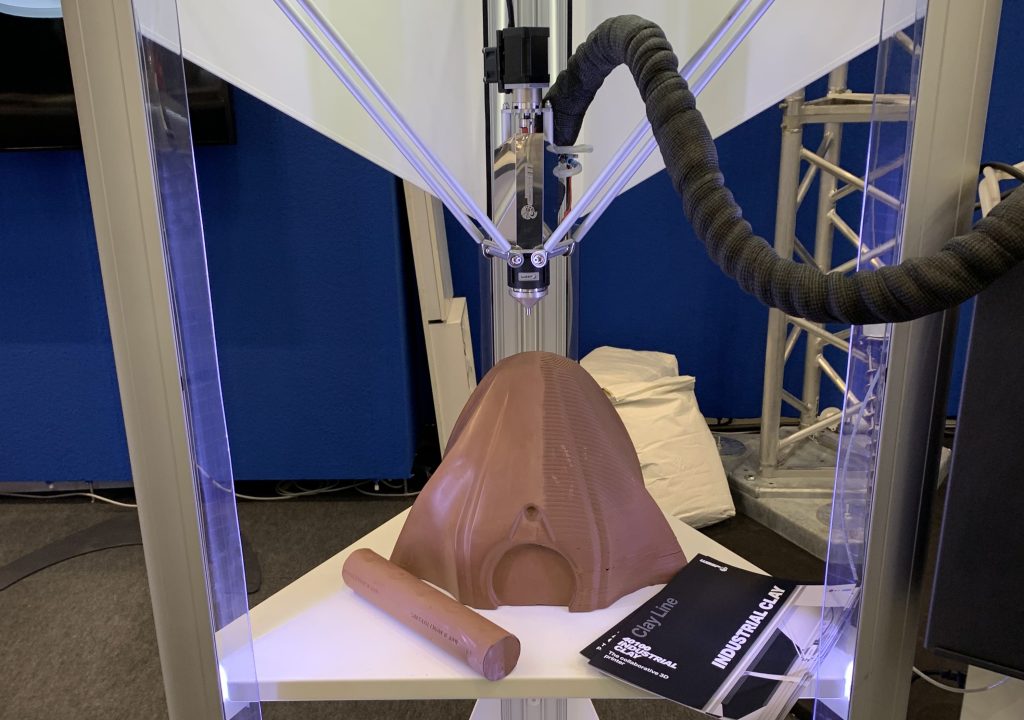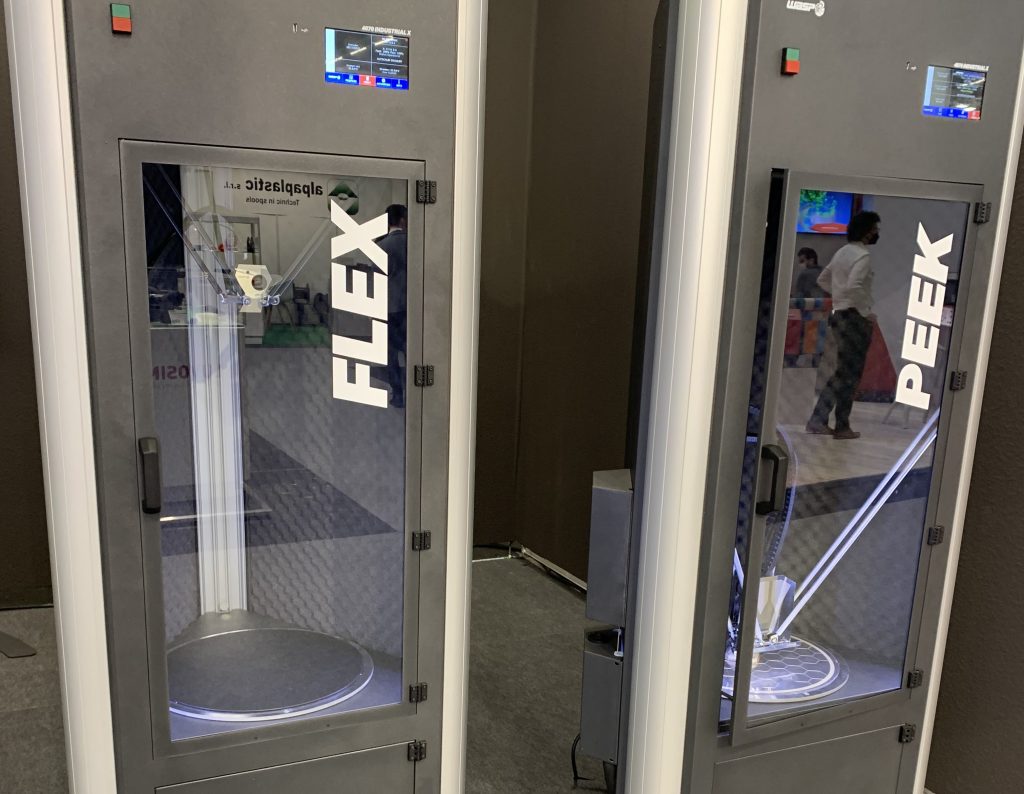Italian construction system manufacturer WASP has added no fewer than eight new products to its large-format 3D printing portfolio at the Formnext 2021 trade show.
Of WASP’s six new printers, five are polymer machines which have been newly-optimized for depositing specific types of filaments or pellets, in a way that could enable medical or architecture users to slash their costs and lead times.
To help unlock the potential of its existing DeltaWASP 40100 system, the firm has also launched a continuous feeding unit and robotic arms for the machine, alongside an ‘Industrial Clay’ variant. Together, these new products are said to provide adopters with a more consolidated, automated workflow, whether that be in the deposition of fluidic concrete and plastics, or the creation of precise clay automotive prototypes.

WASP’s buzzing AM business
Founded in 2012, WASP is a company dedicated to the development of circular 3D printing technologies that unlock sustainable construction at scale. Since the launch of its initial PowerWASP system, the firm has gone on to establish a strong portfolio of Liquid Deposition Modelling (LDM)-powered DeltaWASP 3D printers, including its most recent 3MT, 4070 TECH and 2040 iterations.
While each of these machines feature the same delta coordinate setup, where the stepper motors operate in a triangular formation to closely control their nozzle’s XYZ coordinates, they are optimized for 3D printing concrete, PEEK and ABS respectively.
In addition to its ‘Delta’ machines, WASP also markets its ceramic and high-grade material focused ‘Clay’ and ‘Industrial’ systems, as well as its modular ‘Crane’ construction units. Working with the likes of Mario Cucinella Architects and Dior, the firm continues to deploy the latter to scale new heights in sustainable housing, first 3D printing a ‘TECLA’ eco-house, then a beachside pop-up store in Dubai.
Within its clay portfolio, on the other hand, the company unveiled a unique hybrid prototyping approach last year, with which it claims that automotive users can reduce their products’ time to market without losing any of the artistry in their vehicle design, thus at Formnext it has now released a spate of new products that are designed to allow users to explore this potential application even further.

Sculpting clay auto-applications
WASP dedicated one of its Formnext booths to its latest LDM advances, including the launch of a new edition of its 40100 machine. Known as the ‘40100 Industrial Clay,’ the 400 x 450mm system features an auger-driven extruder which is compatible with 4, 6 and 8mm nozzles, and capable of printing 1mm layers at up to 150mm/s.
Described by the firm as a “collaborative 3D printer,” the Industrial Clay was developed in tandem with Honda, specifically to target automotive prototyping and product design applications. At its Hall 12.0 booth, WASP showed how the technology had enabled it to work with the Japanese automotive firm, to create practical models in a way that allowed for “an unprecedented freedom in manufacturing.”
According to WASP’s Lorenzo Filipponi, its displayed clay-printed motorbike model was built as part of an ongoing project between the companies using a condensed process that cuts out the need for milling, reducing its lead time by around a third.
Filipponi also said that one of the main drawbacks to using its 40100 machine in the past had always been its limited powder capacity, which meant that users often had to refill it multiple times when printing larger parts. In doing so, manufacturers were not only forced to spend their valuable time completing a laborious manual task, but they risked compromising the integrity of models with air bubbles.
To help tackle this refilling issue, WASP launched a continuous powder feeding system at the show too. Weighing in at 30kg, the titanium 11-liter smart-tank features compatibility with nozzles up to 8mm wide, controllable material dosage and nylon wheels at its base, allowing adopters to conveniently top up their machine in an space-efficient way.
On the theme of automation, the firm also unveiled a robotic arm system at its LDM booth, capable of depositing fluid-dense materials such as concrete and plastic granules, which Filipponi said is designed to accelerate the prototyping of large-format parts, and has previously been used within maritime R&D to optimize yacht components.

A refreshed industrial FDM lineup
At its other stand on floor 12.1, meanwhile, WASP revamped its FDM offering with five new Industrial-line systems: the 3MT HDP, 4070 HDP, 4070 TX, 4070 FX and 4070 ZX. With the former two, the company has launched two large-volume pellet-extrusion machines, which are designed to process recycled polymer granules, in a fast, precise, cost-effective and ultimately more sustainable way.
In essence, the 3MT HDP and 4070 HDP printers are able to achieve this thanks to their built-in HDP extruders, that rely on a capacitive sensor to continuously deposit granules where needed. The machines are also able to reach 250° without overheating due to their integrated Firecap systems, while their Vacuum Active Control plates enable parts to be rapidly replaced without disrupting build quality.
Speaking to 3D Printing Industry at the booth, WASP’s Camilla Bruno explained that these features allow the machines to produce enormous eco-friendly architecture, and the 3MT HDP was displayed creating a chair in live-action during the show.
Elsewhere, Bruno suggested that the firm’s other four FDM 3D printers are built to be “more streamlined” versions of its Industrial X machines. Given that each system is now designed to process a specific type of carbon, pellet, PEEK or polycarbonate, she added that “adjustments are no longer needed” to switch between materials, making them ideal for meeting specific medical or construction applications.
In practise, this means the Industrial FDM machines incorporate single specialized extruders, as opposed to the dual-extruder set up of the Industrial X. Additionally, while each system includes the same print bed, their layout has been optimized to certain materials, for instance, the 4070 TX features an inline filament drying system, while the 4070 FX is capable of printing soft materials at a shore hardness of 50A.
More information about WASP’s latest launches can be found via its store page.
To stay up to date with the latest 3D printing news, don’t forget to subscribe to the 3D Printing Industry newsletter or follow us on Twitter or liking our page on Facebook.
For a deeper dive into additive manufacturing, you can now subscribe to our Youtube channel, featuring discussion, debriefs, and shots of 3D printing in-action.
Are you looking for a job in the additive manufacturing industry? Visit 3D Printing Jobs for a selection of roles in the industry.
Featured image shows WASP’s new Flex and PEEK-optimized machines on display at Formnext 2021. Photo by Paul Hanaphy.



